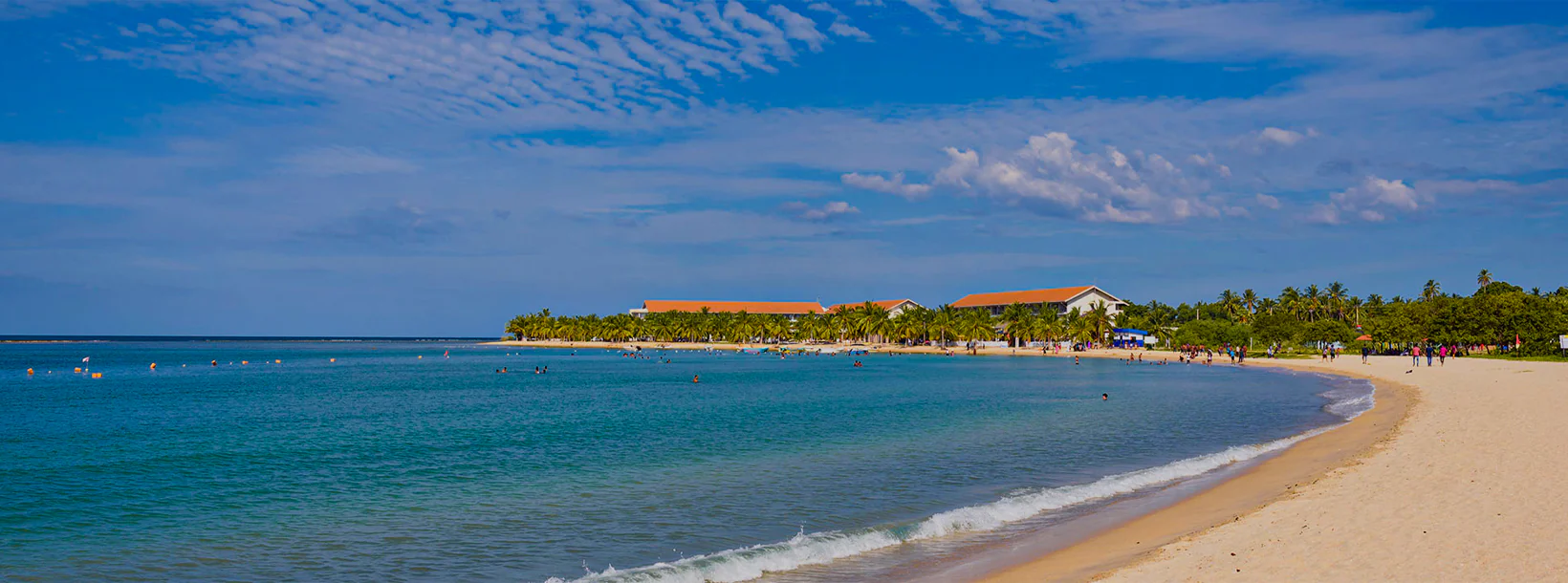
Pasikuda City
Discover Pasikuda's serene beauty on Sri Lanka's eastern coast. With its powdery white beaches and crystal-clear waters, Pasikuda is a tropical haven. Explore vibrant coral reefs, relish local delicacies, and unwind in tranquility. Experience paradise at its finest in Pasikuda.
Passikudah Beach
Pasikudah Beach, located on the eastern coast of Sri Lanka, is celebrated for its stunningly shallow waters, golden sands, and tranquil atmosphere. Known for its serene environment and family-friendly beach experience, Pasikudah Beach is a perfect destination for those seeking relaxation and natural beauty.
Shallow, Calm Waters
Pasikudah Beach is renowned for its shallow waters that stretch far out into the sea, creating a large, safe area for swimming and wading. The calm, warm waters are ideal for families with children, as they provide a gentle and secure environment for beach activities.
Golden Sands and Relaxation
The beach features pristine golden sands perfect for sunbathing, picnicking, and leisurely beach walks. The wide expanse of the beach offers plenty of space for relaxation and enjoying the sun in a peaceful setting.
Water Sports and Activities
While the shallow waters are excellent for swimming, Pasikudah Beach also offers opportunities for various water sports. Visitors can enjoy activities such as jet skiing, windsurfing, and snorkeling. The calm conditions make it a great spot for beginners to try out these exciting sports.
Nearby Attractions
In addition to the beach itself, several attractions and activities can be enjoyed in the surrounding area:
- Kalkudah Beach: Close to Pasikudah, Kalkudah Beach offers similar beautiful sands and waters, providing additional opportunities for beach enjoyment and relaxation.
- Arugam Bay: Located further south, Arugam Bay is renowned for its surfing and vibrant beach culture, offering a lively contrast to the tranquil atmosphere of Pasikudah.
- Nilaveli Beach: North of Pasikudah, Nilaveli Beach features beautiful stretches of sand and is known for its excellent snorkeling and diving opportunities, including trips to the nearby Pigeon Island.
Local Cuisine
The area around Pasikudah Beach offers a variety of dining options, from casual beachside eateries to upscale restaurants. Local cuisine features fresh seafood and traditional Sri Lankan dishes such as seafood curries, hoppers, and string hoppers, providing a taste of the region’s culinary traditions.
Accommodation
Pasikudah Beach is home to several hotels and resorts that cater to different budgets and preferences. Many accommodations offer beachfront views, direct beach access, and amenities such as swimming pools and spa services, ensuring a comfortable and enjoyable stay.
Best Time to Visit:
The best time to visit Pasikudah Beach is from April to September, when the weather is warm and dry, and the sea conditions are calm. This period provides the best conditions for beach activities and exploring the local attractions. The monsoon season typically starts in October, bringing heavy rains and rougher sea conditions.
About Batticaloa District
Batticaloais a city in the Eastern province of Sri Lanka.Batticaloa is in the eastern coast of Sri Lanka on a flat coastal plain boarded by the Indian Ocean in the east occupies the central part of the eastern Sri Lanka. Batticaloa is on the East coast, 314 km from Colombo. The population of 515,707 consists mainly of Tamils, Moors, Sinhalese, Euro-Asian Burghers (specifically Portuguese Burghers and Dutch Burghers) and indigenous Vedda population.
Rice and coconuts are the two staples of the district, and steamers trading round the island call regularly at the port. The lagoon is famous for its ""singing fish,"" supposed to be shell-fish which give forth musical notes. The district has a remnant of Veddahs or wild men of the wood.
The city has four main divisions.
Pullianthivu: Seat of many government department and offices, schools, banks religious places, General Hospital, Weber Stadium and Shops. Nowadays many NGO offices including ICRC, UN, UNICEF, WORLD VISION etc.are located also.
Koddamunai: Schools, Banks,Sri Lanka Telecom regional office for East, Shops and many government offices are located. Two bridges called Perya Palam and Puthuppalam are connect Pulianthivu Island with Koddaminai land mass.
Kallady: Here there are many Government buildings and private industries, schools, hospitals and Eastern University Medical Faculty. Kallady Lady Manning Bridge (the longest bridge in Sri Lanka connects Kallady and Arasay.
Puthur: This is where the dom
About Eastern Province
The Eastern Province is one of the 9 provinces of Sri Lanka. The provinces have existed since the 19th century but they didn't have any legal status until 1987 when the 13th Amendment to the 1978 Constitution of Sri Lanka established provincial councils. Between 1988 and 2006 the province was temporarily merged with the Northern Province to form the North-East Province. The capital of the province is Trincomalee. The Eastern province's population was 1,460,939 in 2007. The province is the most diverse in Sri Lanka, both ethnically and religiously.
Eastern province has an area of 9,996 square kilometers (3,859.5 sq mi).The province is surrounded by the Northern Province to the north, the Bay of Bengal to the east, the Southern Province to the south, and the Uva, Central and North Central provinces to the west. The province's coast is dominated by lagoons, the largest being Batticaloa lagoon, Kokkilai lagoon, Upaar Lagoon and Ullackalie Lagoon.











